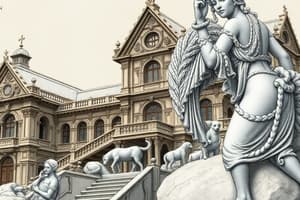Podcast
Questions and Answers
Which mineral is an example of cleavage exhibiting two directions?
Which mineral is an example of cleavage exhibiting two directions?
- Mica
- Orthoclase (correct)
- Halite
- Fluorite
What is the characteristic of minerals that do not exhibit cleavage?
What is the characteristic of minerals that do not exhibit cleavage?
- They always contain metallic properties.
- They exhibit conchoidal fracture. (correct)
- They have high densities.
- They react vigorously with acid.
Which mineral reacts with hydrochloric acid and produces fizzing?
Which mineral reacts with hydrochloric acid and produces fizzing?
- Halite
- Talc
- Calcite (correct)
- Quartz
Which mineral is characterized as feeling greasy to the touch?
Which mineral is characterized as feeling greasy to the touch?
What property distinguishes metallic minerals from non-metallic minerals?
What property distinguishes metallic minerals from non-metallic minerals?
Which of the following is NOT a characteristic of minerals?
Which of the following is NOT a characteristic of minerals?
What does the streak of a mineral refer to?
What does the streak of a mineral refer to?
Which of the following minerals has the highest hardness on the Mohs scale?
Which of the following minerals has the highest hardness on the Mohs scale?
What is the primary difference between cleavage and fracture in minerals?
What is the primary difference between cleavage and fracture in minerals?
Which term describes how a mineral's surface reflects light?
Which term describes how a mineral's surface reflects light?
What is the significance of a mineral's crystal form?
What is the significance of a mineral's crystal form?
Which of the following minerals exhibits metallic luster?
Which of the following minerals exhibits metallic luster?
On the Mohs scale, which object has a hardness of approximately 5.5?
On the Mohs scale, which object has a hardness of approximately 5.5?
Flashcards
Cleavage
Cleavage
The tendency of a mineral to break along specific planes of weakness, resulting in smooth, flat surfaces.
Fracture
Fracture
Minerals that do not break along specific planes, instead fracturing in an irregular or uneven manner.
Conchoidal Fracture
Conchoidal Fracture
A type of fracture that produces smooth, curved surfaces resembling the interior of a shell.
Density
Density
Signup and view all the flashcards
Distinctive Properties
Distinctive Properties
Signup and view all the flashcards
What is a mineral?
What is a mineral?
Signup and view all the flashcards
What is a mineral's streak?
What is a mineral's streak?
Signup and view all the flashcards
How is a mineral's luster described?
How is a mineral's luster described?
Signup and view all the flashcards
What is a mineral's hardness?
What is a mineral's hardness?
Signup and view all the flashcards
What is a mineral's crystal form?
What is a mineral's crystal form?
Signup and view all the flashcards
What is a mineral's cleavage?
What is a mineral's cleavage?
Signup and view all the flashcards
What is a mineral's fracture?
What is a mineral's fracture?
Signup and view all the flashcards
What is a mineral's density?
What is a mineral's density?
Signup and view all the flashcards
Study Notes
Earth's Crust Composition
- The Earth's crust is made of minerals and rocks
- Minerals are individual crystals of the same substance
- Rocks are combinations of different minerals
Mineral Criteria
- A mineral must be solid
- A mineral must occur naturally (not man-made)
- A mineral must be made of non-living material
- A mineral has a definite chemical formula
- A mineral has a crystal structure
Mineral Formation
- Mineral crystals form in two main ways:
- From dissolved substances in liquids (like evaporation or hot water)
- From cooling molten materials (magma or lava)
Minerals & Crystals from Magma & Lava
- "Extrusive" Cooling (Lava cools fast)
- Minerals form from hot magma or cooling lava
- Cooling produces crystals (minerals)
- Crystal size depends on cooling time (faster cooling = smaller crystals)
- "Intrusive" Cooling (Magma cools slowly)
- Magma cools slowly, producing large crystals
Mineral Crystal Size
- When hot material cools fast, crystals are small
- When hot material cools slowly, crystals are large
- Granite has visible crystals due to slow cooling
- Rhyolite has small crystals due to fast cooling
Minerals formed by Evaporation
- Minerals form when solutions or mixtures evaporate
- Evaporation leaves behind dissolved substances
- The longer the evaporation process, the larger the crystal
- Salt (halite), gypsum, and calcite are examples from ocean water
What is a Mineral?
- A mineral is a naturally occurring, inorganic solid
- It has an ordered internal arrangement of atoms (crystalline structure)
- It has a definite (but not always fixed) chemical composition
Identifying Minerals
- Physical properties are used to identify minerals
- Properties include:
- Luster (how light reflects off the surface)
- Metallic or non-metallic
- Streak (color of a mineral's powder)
- Crystal Shape (specific geometric form)
- Hardness (resistance to scratching; measured by the Mohs Scale)
- Color (can be misleading, due to impurities)
- Special Properties (magnetism, fluorescence, reactivity with acid)
- Density (mass per unit volume)
- Cleavage (how a mineral breaks along flat planes)
- Fracture (how a mineral breaks along irregular surfaces)
- Luster (how light reflects off the surface)
- Optical properties – light transmission
- Opaque (light doesn't pass through)
- Translucent (light passes through but not an image)
- Transparent (light and images pass through)
Hardness: The Mohs Scale
- Hardness measures resistance to scratching
- The Mohs scale ranks minerals 1 (softest) to 10 (hardest)
- Common objects have hardness values
Mineral Classification (by chemical composition)
- Silicates (most common, containing Si and O)
- Oxides (containing O and a metal)
- Sulfates (containing S and O)
- Sulfides (containing S and a metal)
- Carbonates (containing CO3)
- Halides (containing a halogen element)
- Native Elements (composed of a single element)
Studying That Suits You
Use AI to generate personalized quizzes and flashcards to suit your learning preferences.




